Basionym: Echinocactus bicolor Galeotti ex Pfeiffer, Abbild. Beschr. Cact. 2: Pl. 25 (1848).
Lectotype: Abbild. Beschr. Cact. 2: Pl. 25 (1848), E.F. Anderson, Bradleya 5: 59 (1987).
Synonyms: Echinocactus bicolor Galeotti ex Pfeiffer, Abbild. Beschr. Cact. 2: Pl. 25 (1848). Thelomastus bicolor Frič, in Kreuzinger, Verzeichnis 10 (1935), nom. illeg. Ferocactus bicolor (Galeotti ex Pfeiffer) N. P. Taylor, Cact. Succ. J. Gr .Brit. 41: 30 (1979). Echinocactus rhodophthalmus Hooker, Bot. Mag. 76: pl. 4486 (1850). Echinocactus rhodophthalmus var. ellipticus Hooker, Bot. Mag. 78: pl. 4634 (1852). Echinocactus ellipticus Lemaire, Jard. Fleur. 3: pl. 270 (1853). Echinocactus bicolor var. schottii Engelm., Proc. Amer. Acad. 3: 277 (preprint 1856). Echinocactus schottii Small, Fl. Southeast U. S. 814 (1903). Thelocactus bicolor schottii Davis ex Backeb., Die Cactacecae V: 2809 (1961), nom. inval. Thelocactus bicolor var. schottii Krainz, Die Kakteen, Lfg. 18 (1961). Echinocactus bicolor var. montemorelanos Weber, Dict. Hort. Bois 465 (1896), nom. nud. Echinocactus bicolor var. tricolor Schumann, Gesambt. Kakt. 303 (1898). Thelocactus bicolor var. texensis Backeb., Die Cact. 6: 3872 (1962), nom. inval. Thelocactus bicolor var. huizachensis Kladiwa & Fittkau, nom. prov., in Krainz, Die Kakteen. CVIII b. 1. IV. (1975). Thelocactus bicolor var. commodus Haas, Kakt. and. Sukk. 39: 86 (1988). Thelocactus bicolor ssp. commodus (Haas) Doweld, Sukkulenty 1: 30 (1999). Thelocactus bicolor ssp. zwakii Chvastek & Halda, Acta Mus. Richnov. Sect. nat. 7: 38 (2000).
Description
Stem single, ovoidal, 8-20 cm tall, 5-12 cm wide. Ribs 8, distinct. Tubercles rounded. Areoles with glands. Central spines 3-4, 15-75 mm long, ochre to reddish, straight, acicular. Radial spines 8-18, 10-30 mm long, ochre to reddish, straight, acicular. Flowers 55-110 mm wide, magenta with a red throat. Seeds 1.9 x 1.4 mm, testa cells convex with a verrucose surface sculpture.
Distribution
USA, Texas, Brewster and Starr Counties; Mexico, Coahuila, Nuevo León, San Luis Potosí, and Zacatecas, occurring in matorral xerofilo on limestone or sandstone slopes or outcrops, at elevations of about 400 to 2400 metres above sea level. Its range lies within the Northern Chihuahuan, Central Chihuahuan and Meseta Central subregions of the Chihuahuan Desert ecoregion, and the Tamaulipan Matorral ecoregion.
Comments
This species is fairly common in cultivation due to its ease of cultivation and the beautiful flowers freely produced from early spring to autumn. It is widely distributed in habitat too, its range going from Texas to San Luis Potosí in central Mexico. This extensive distribution range has led to the formation of many local forms which in the years have been formally named. Most of these names are not accepted by many botanists that treat them as synonyms, but they still have a value for a collector because they identify plants with particular characters.
Rhodophthalmus and ellipticus are referable to bicolor.
Commodus occurs from an area near Montemorelos, Tamaulipas, outside the limits of the Chihuahuan Desert. It has been described as having only one, porrect, central spine, but with a careful observation it is possible to notice that the upper central spines are so appressed to the stem that they can be easily mistaken for radials. Therefore commodus has three central spines, as does the type species, and its maintenance at variety or subspecies rank is not justified.
Schottii is poorly known. This epithet has been applied by Benson to the plants coming from the Big Bend area, which are characterized by a very long, papery upper spine. No other differences have been reported, so that, eventually, this entity has been added to the synonymy of bicolor.
Texensis is an invalid name published by Backeberg applying to a Texas form.
Tricolor has been described by Schumann and refers to a form with bright red spines. Plants with these characters can be found around Saltillo, Coahuila.
Zwakii, which is reported from Castaños in Coahuila, has been described as having smaller stem and flowers. It is not sufficiently distinct to deserve a subspecies rank.
Thelocactus bicolor ssp. bicolor (Galeotti ex Pfeiffer) Britton & Rose, Bull. Torrey Bot. Club 49: 251 (1922).
 The lectotype of Echinocactus bicolor Galeotti ex Pfeiffer
The lectotype of Echinocactus bicolor Galeotti ex Pfeiffer
From: L. Pfeiffer und Fr. Otto, Abbildung und Beschreibung blühender Cacteen, Plate 25 (1848).
enlarge
Image courtesy Missouri Botanical Garden.
Botanicus Digital Library
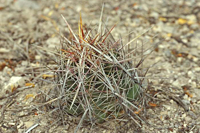 Thelocactus bicolor
Thelocactus bicolor
Huizache, San Luis Potosí
Photo: A. Mosco
enlarge
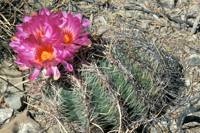 Thelocactus bicolor
Thelocactus bicolor
El Chiflón, Coahuila
Photo: J. Jauernig
enlarge
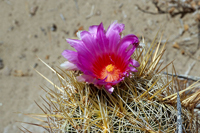 Thelocactus bicolor
Thelocactus bicolor
between Saltillo and Torreón, Coahuila
Photo: A. Mosco
enlarge
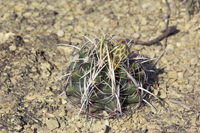 Thelocactus bicolor "commodus"
Thelocactus bicolor "commodus"
Montemorelos, Nuevo León
Photo: J. Jauernig
enlarge
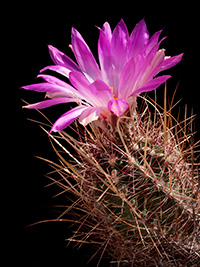 Thelocactus bicolor "schottii"
Thelocactus bicolor "schottii"
SB 567 Brewster Co., Texas
Photo: A. Mosco
enlarge